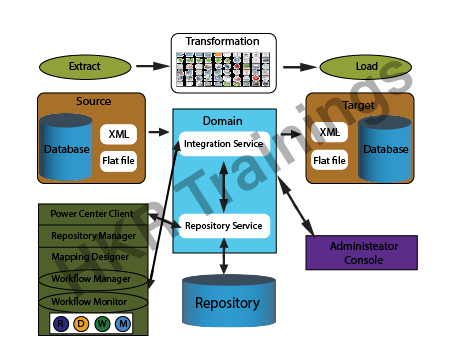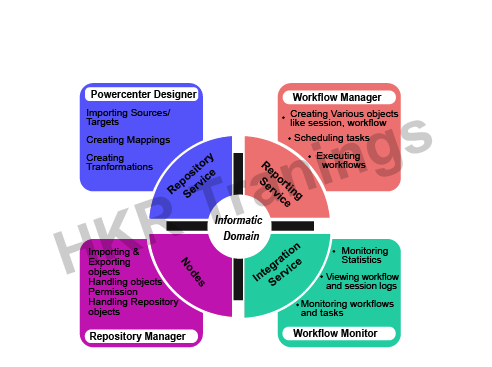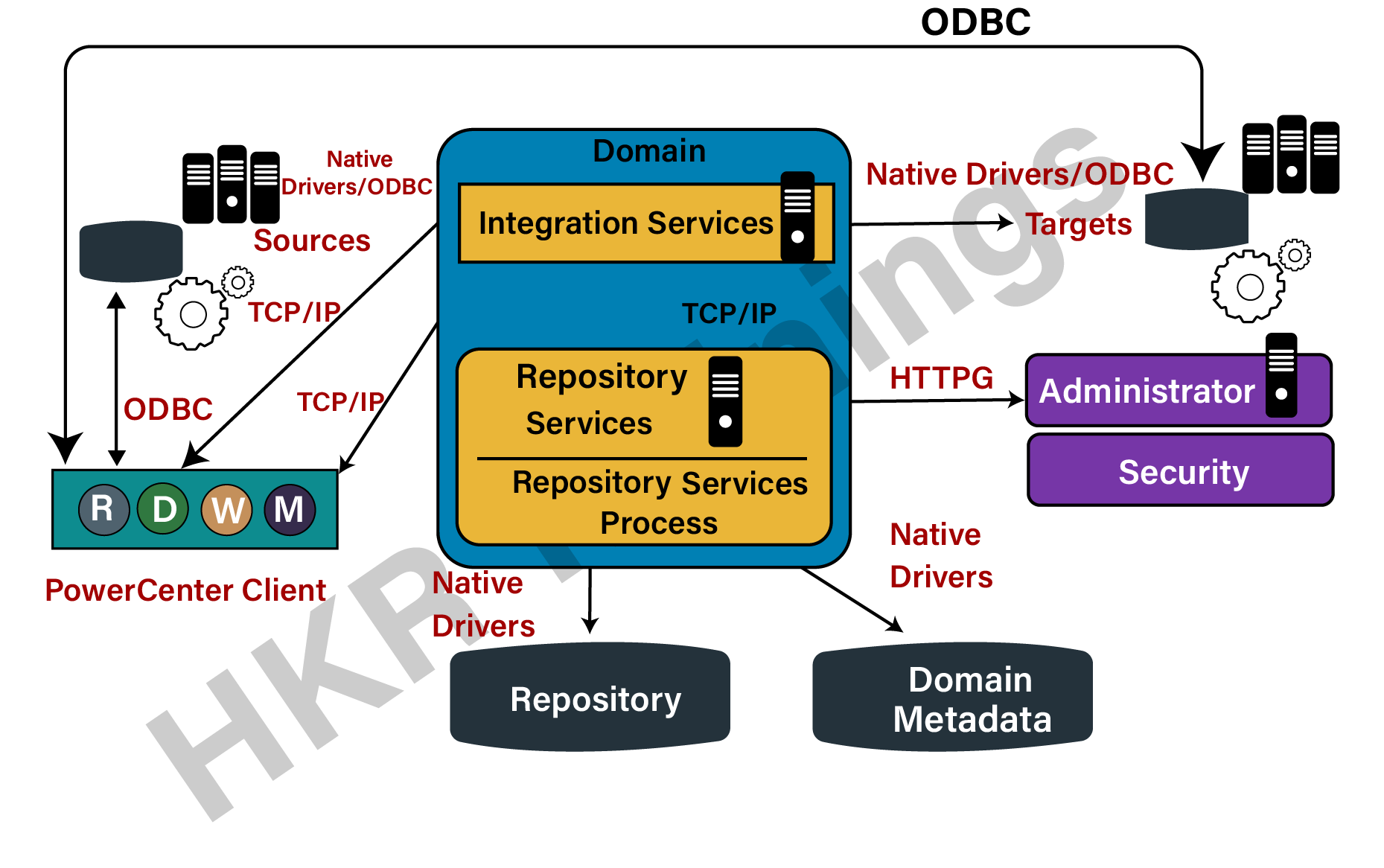Informatica Architecture:
The architecture of Informatica is service-oriented (SOA). A service-oriented architecture is a collection of services which interact with one another. It could be a basic data transfer or two or even more services coordinating the same action throughout this interaction.
Informatica growth is dependent on component-based development techniques. To achieve the desired result, this technique employs predefined components and functional departments with their associated functionalities.
Become a Informatica Certified professional by learning this HKR Informatica Online Training !
PowerCenter is built using element methodology. The process of constructing a dataflow from source to target involves the use of various components, which is known as transformation.The Informatica ETL tool includes the following services and components:

- Repository Service: This service is in charge of keeping Informatica metadata and providing access to that to other services.
- Integration Service: This service facilitates the transfer of data from sources to targets.
- Reporting Service: This service is in charge of producing reports.
- Nodes: This is really a software device used to carry out the aforementioned services.
- Informatica Designer: It is responsible for creating mappings between source and target.
- Workflow Manager: It's being used to generate workflows as well as other tasks, as well as to execute them.
- Workflow Monitor: It's being used to keep track of how workflows are being executed.
- Repository Manager: This application is used to handle the objects inside the repository.


Informatica Certification Training
- Master Your Craft
- Lifetime LMS & Faculty Access
- 24/7 online expert support
- Real-world & Project Based Learning
Informatica Domain:

- The Informatica domain serves as the primary administrative division.
- Informatica is made up of nodes and services. Premised on administration requirements and design architecture, these nodes and services are organised into folders or subfolders.
- The Informatica administrator's Console web page creates a domain that resembles a folder. We could indeed generate a node with the services inside this folder.
- A node is a logical depiction of a machine in the Informatica domain. In Informatica, all services and processes run within the domain. A single domain can contain multiple nodes. A gateway node receives client requests and routes them to the appropriate service.
- The domain offers two types of services, including:
- It handles domain operations including such logging, authentication, and authorization. It manages users and groups and runs the application services on the nodes.
- Application Services: These are server-specific services like repository services, reporting services, as well as integration services. Depending on the configuration, the application service can run on multiple nodes.
Node:A node seems to be a reasonable analysis of a machine in a domain, and a domain has various hubs. We could indeed create hubs, such as mix administration, to run application administrations.
PowerCenter Repository:A relational database, such as SQL Server, Oracle, or Sybase, serves as the PowerCenter repository. And the repository services are in charge of maintaining these databases. The metadata is stored in the database tables.
Informatica client tools are classified into three types:
- Informatica designer
- Workflow manager for Informatica
- Informatica workflow supervisor
Informatica is often used to handle the repository and provides repository services. The repository services only handle one request per repository. However, we can run it on multiple nodes to improve performance.
Because of its version control mechanism, we can keep different versions of the same objects. Also, disregard multiple users who are modifying the same object at the same time.This three-state is present in the objects created in the repository, such as:
- As per Informatica, valid objects have the correct syntax. And it is used to carry out the workflow.
- Invalid objects do not adhere to the standard or rules. During the object's save in Informatica, these objects checked whether the syntax and properties were valid or not.
- Affected: The affected object's child objects are invalid.

Subscribe to our YouTube channel to get new updates..!
PowerCenter Repository Service:
The PowerCenter repository service is a separate multi-step process. It enables customers to modify the metadata in the store. It accepts metadata requests from the respectful benefit in order to run work processes.
And the repository service keeps PowerCenter customers' connections to the PowerCenter vault up to date. It inserts the metadata into the archive and keeps it up to date. It can maintain consistency within the archive metadata.
Domain Configuration:
The domain is a necessary fundamental administrative control in the Informatica ETL tool. It is a visible entity that offers a variety of services such as repository service, integration service, and various nodes. The Informatica admin console is used to configure the domain. In addition, web browsers are used to launch the console.
Connectivity of the PowerCenter Client and Server:
Client-side machines have PowerCenter client tools installed. Workflow manager, PowerCenter designer, repository manager, and workflow monitor are examples of development tools.
All mapping as well as objects created in these client tools are stored in the Informatica repository, which is located on the Informatica server. As a result, client tools must be network-connected to the server.
In addition, the PowerCenter client connects to the sources and targets in order to import metadata and structure definitions. As a result, it maintains connectivity to the source or target systems.
- TCP/IP protocols are used by the PowerCenter client to connect to the integration and repository services.
- And the PowerCenter client connects to the source or target using ODBC drivers.
Top 30 frequently asked Informatica Interview Questions !
Repository Service:
The repository service runs in multiple threads. It keeps the PowerCenter clients and the PowerCenter repository connected.The repository service has access to the repository's metadata and can retrieve, insert, and update it. It also ensures consistency within the repository metadata.
Integration Service:
In Informatica, the integration service serves as an execution engine. It aids in the execution of tasks created in Informatica. The integration service operates in the following ways:
- A workflow is carried out by a user.
- Informatica directs the integration service to carry out the workflow.
- The integration service then retrieves workflow details from the repository.
- The integration service initiates the execution of the tasks contained within the workflow.
- Following implementation, the task condition is modified, such as Succeeded, Failed, or Aborted.
- The session log as well as workflow log are then granted.
- This service transfers data from the source systems to the target systems.
- The integration service combines information from diverse sources.
Conclusion:
In the above blog post we had discussed informatica, informatica architecture in depth. Had any doubts stop your queries in the comments section to get them resolved. Happy learning!
Related Articles:
- Talend Vs Informatica
- Informatica Transformations
- Informatica bdm Training
About Author
As a senior Technical Content Writer for HKR Trainings, Gayathri has a good comprehension of the present technical innovations, which incorporates perspectives like Business Intelligence and Analytics. She conveys advanced technical ideas precisely and vividly, as conceivable to the target group, guaranteeing that the content is available to clients. She writes qualitative content in the field of Data Warehousing & ETL, Big Data Analytics, and ERP Tools. Connect me on LinkedIn.
Upcoming Informatica Certification Training Online classes
| Batch starts on 20th Dec 2025 |
|
||
| Batch starts on 24th Dec 2025 |
|
||
| Batch starts on 28th Dec 2025 |
|

